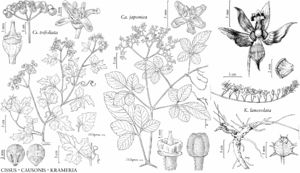Causonis
Med. Fl. 2: 122. 1830.
| Taxon | Illustrator ⠉ | |
|---|---|---|
 | Cissus trifoliata Causonis japonica Krameria lanceolata | Alice Tangerini Alice Tangerini |
Vines [lianas], sprawling to moderately high climbing, synoecious or polygamomonoecious. Branches: bark adherent; pith white, continuous through nodes; tendrils usually 2–3 [–5] -branched, without [with] adhesive discs. Leaves palmately (pedately) compound. Inflorescences usually bisexual, axillary, corymblike cymes, compound. Flowers bisexual or unisexual; calyx cupshaped, indistinctly 4-lobed; petals 4, distinct; nectary adnate to base of ovary, cupshaped, 4-lobed; stamens 4; style conic, short. Berries dark blue to black. Seeds 2–4 per fruit. x = 10.
Distribution
Introduced; e, se Asia, Australia
Discussion
Species ca. 25 (1 in the flora).
Causonis is separated from Cayratia (Wen J. et al. 2013) based on phylogenetic evidence (Wen et al. 2007; Lu L. M. et al. 2013). It corresponds to the Asian and Australian Cayratia sect. Discypharia Suessenguth (K. Suessenguth 1953; A. Latiff 1981). Causonis trifolia (Linnaeus) Rafinesque, native to southeast Asia and Australia, is an aggressive weed at Fairchild Tropical Garden in Miami, Florida. No other locations are known for this species in the flora area, but it may become naturalized in southern Florida. It can be distinguished from C. japonica by having 3-foliolate leaves and tendrils that are 3–5-branched and usually have adhesive discs at their tips.
Selected References
None.
Lower Taxa
"connate" is not a number.